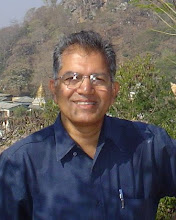I had hoped to spend a year of contemplation and gardening, or contemplative gardening. It has turned out differently: there is not much contemplation and no gardening. So what have I been busy with? The De Smet book, mainly. Not a very creative enterprise, but certainly an act of pietas, and also – something that vibes with the ‘ordering’ part of my temperament….
So now I have committed to preparing a paper for the June 2009 Lonergan Workshop, but I still find myself drawn to spending time on the next De Smet project: a collection of his Śaṅkara studies. These are many more than the Person studies, but then there is also the experience gathered, and I have the impression that this project will not take me as long as the earlier one. Still, it is taking time, swallowing up time.
For the Workshop I decided to extend my introduction to the Brahman and Person book. I take up De Smet’s ‘retrieval’ or ‘generation’ of the category of person in Indian thought, and see what can be made of it within Lonergan’s method. This would entail, perhaps, studying Lonergan – not so much because I need to study Lonergan, but because I would need to transpose ‘person’ into categories drawn from interiority. The prime candidate for the transposition is ‘subject’, but subject does not quite have the concreteness of person, and that is a problem which I must study. – So I expect De Smet to provide an example of the generation of categories; or else it would be an instance of ‘studies of interiority’ in other traditions (part of the generation of special theological categories). And I would be ‘retrieving’ De Smet’s work from a methodological standpoint.
Something similar might happen w.r.t. his Śaṅkara studies, though perhaps there we would be entering doctrines or perhaps systematics. For where would creation fit? Or better, where would Śaṅkara’s thinking on creation fit? Śaṅkara is a śrutivādin, as De Smet has insisted. He is probably doing systematics, then.
And what about the famous Bibliography of Indian Christian Writings project? Even the promised contributions have not yet materialized. But I would need to spend perhaps a day going through the work of Hambye, and that of Kaj Baajo, and the bibliographies produced by the Heras Institute. That might give me a scheme, at least for the ancient authors, say up to the 19th century. The 20th century would be a very vast enterprise, and that too could be broken up conveniently into pre- and post-conciliar periods.
And then there is the journal, and the nitty-gritty of classes and theses. I have enjoyed doing Aesthetics, and in the bargain have discovered that the reading method – together with a sidelong bow to Montessori’s insistence on the data, the experience – is excellent for arousing, evoking, and holding the attention of the students. What has been amazing also is that they have managed, first years as they are, to follow the philosophers in some way up to Heidegger. Managed is not to say that there has been deep or profound philosophizing – but they have not been turned off, I have not seen anyone drowning, and that itself is very good. Plato coming alive, and also Heidegger…. What more could one want.
But contemplative leisure is important for truly reading, and understanding, and thinking, and creating. Heidegger’s Holzwege arise upon years and years of such contemplative thinking. One has to spiral into the meaning of an author, rise up to his level, so that then one can understood as he has understood and with him. One has to learn to read. And for that one has to slow down. And one begins by walking slower, doing one thing at a time, not cribbing time for prayer, and also playing – which does not mean only football and basketball, but the engaging with the other – the other person, the other kind of book, the newspapers and the magazines and the movies and the novels too.
Sunday 15 February 2009
Subscribe to:
Post Comments (Atom)

No comments:
Post a Comment